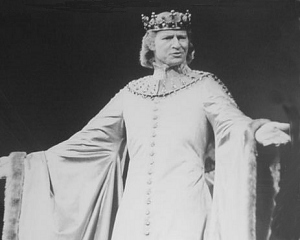|
"We had no intentiion of doing them this year
but we were desperate for popular plays," Terry Hands explained. "We suddenly
found ourselves doing them before we wanted to because we were in such dire
financial straits last year.
Character
Both are, as he says, "much-loved plays," although of markedly
different character. "I suspect that this reflects the different audiences they
were written for. Richard II was written for the young men of the Inns
of Court. It's an aristocratic, witty play, conceited in the metaphysical
sense, whereas Richard III seems intended for the open-air playhouse, and it's
very much an actor's play.
"Richard III was one of the most popular
plays of Shakespeare's own time and has retained its popularity. Richard
II was a politically sensitive play in its time, and the Queen would not
allow the deposition scene to be shown."
Although he has directed Richard III
before, Hands has always put off doing Richard II. Three times he has
been offered the opportunity of directing it at Stratford and he has turned it
down in favour of The Merry Wives of Windsor, Pericles and,
ironically, Richard III.
"It's odd finally to be coming back to it.
Perhaps I was too young to understand it in those days. I used to see as self
pity this man's desire to become nothing, because only that way can he find out
who he is. Still, whenever I think I have begun to understand a Shakespeare
play I usually find myself in trouble."
But the fact that he is treading new ground in
Richard II should not, he thinks, mean that his Richard III will
seem stale by comparison. "It's a such a rich cauldron of a play, and Alan
Howard discovers extraordinary things in it. It's a very good company; we have
the luxury, for instance, of Dicky Pasco playing Clarence, David Suchet doing
one scene as King Edward, and Jane Shore has three lines.
"It's a great circus play; it's almost as
though people come on and do a number. If you can get really good actors you
get a marvellous extra push."
Experience
How much has the experience of working through the other history
plays contributed to the productions? "It has helped because you know what it
all led to: it makes you aware of the significance of the Bishop of Carlisle's
prophecy in Richard II. And having done Henry V and knowing how
obsessed he was with the murder of Richard II does enable you to put that extra
weight here and there."
But doing the rest of the cycle has been no
real help at all in terms of style, because "most of Shakespeare's plays are
unique in writing, so that you need a totally different style for each of
them."
On stylistic grounds, he believes the history
plays were written in a haphazard sequence which bears no relationship to their
chronological order.
"Richard II is closer to Love's
Labour's Lost or Romeo and Juliet. People don't have lines to speak
to each other, they have speeches. In Richard III the method is that one
character comes on and says I am going to do the following, and then does it."
He dismisses the idea that there may be a Terry
Hands style, preferring to see the plays dictate their own. Richard II,
for example, demands considerable physical beauty in its big court scenes.
Under the watchful and admiring eye of Abdul
Farrah, the RSC's workshops have been experimenting with unfamiliar metalwork
techniques to equip the productions with an impressive glitter of heraldic
badges and devices.
The designer explains: "We are starting as much
as we can by imitating the late Gothic, and the stage should give an impression
of gilded wood, with a combination of pageantry and ritual. So after Richard
II's deposition you have a totally contrary world taking over, a far more
practical, less glamorous world than the Gothic.
Design
All this is achieved with economical means, and the design seems
to have been approached very much from the actor's level, the weight and and
feel of the swords and emblems they carry relating directly to their
performance.
That way of thinking perhaps reflects the
continuity of thought between a director and designer who have made a habit of
working together. "Why do Abdul and I stick together?" asks Terry Hands. "I
suppose because our vices tend to cancel each other out rather than accentuate
each other."
Terry Grimley
The Birmingham Post, 29.10.80
|

